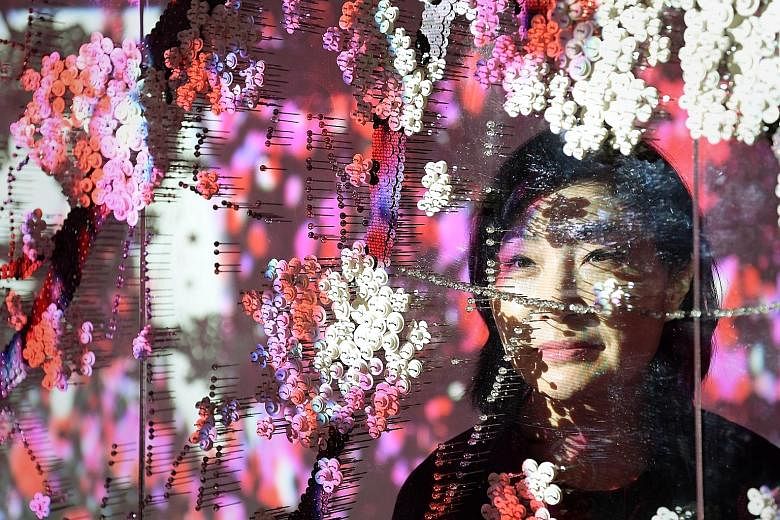The fragility of life has been at the core of South Korean artist Ran Hwang's work ever since she watched the World Trade Center attack on 9/11 in New York.
For a month afterwards, she could see the ashes of the twin towers from her window in Brooklyn.
"From that point," she says, "my thoughts deepened around life and death, creation and demolition."
Such is the existentialism that lies beneath the dreamy plum blossoms and soaring phoenixes of her installation Becoming Again; Coming Together, which was commissioned by the Asian Civilisations Museum to accompany its exhibition on Korea's Joseon dynasty.
It is the largest installation to date by Hwang, 57, who is based in New York and Seoul and speaks partly in English and partly in Korean through a translator.
It evokes the earthly through projections of a wedding couple in hanbok robes and a gallery hung with bunches of white peppers, a Confucian custom that heralds the birth of male offspring, and juxtaposes it with the eternal, represented by phoenixes in flight. Traditional music from the Joseon era plays in the background.
Hwang's installations are laborious affairs. This one involves 50,000 pins, each of which had to be hammered into walls or plexiglass panels at least 25 times to be secure.
The pins hold up handmade paper buttons, beads and about 5km of thread in intricate designs of flowers, spiderwebs and birds.
Hwang, who worked in an embroidery company after graduating from the School of Visual Arts in New York, says she loves pins because "they are the perfect material to connect anything. The pin is a relationship".
All things must pass and so, eventually, will this painstakingly assembled work.
To take down her art when its time is up is still "heartbreaking", she says, but the destruction is a vital part of the process.
"Death is part of life," she says.
"It is our reality. When I was a student in New York, my parents died. I missed their deaths because of immigration issues. But they are always in my heart.
"And that is how it is for exhibitions that are gone - they remain in our hearts."
Four highlights of the era
PORTRAIT OF SEO JIKSU
While such portraits of important figures were common, this one of Confucian scholar and civil servant Seo Jiksu from 1796 is unusual because he is standing and portrayed without shoes.
It is rarely seen even in Seoul, where it is on display only two months in the year at the National Museum of Korea.
The inscription, written by Seo himself, indicates that the portrait was done by two of the era's most famous court painters, Yi Myeonggi and Kim Hongdo.
Despite the intense realism of the portrait, which captures minute details such as his age spots and wrinkles, Seo was reportedly dissatisfied because he felt the artists had failed to depict his inner state of mind.
SUN, MOON, AND FIVE PEAKS SILK
The king himself would have sat enthroned in front of this sixfold screen from the 19th or early 20th century.
While painted folding screens were popular in the latter half of the Joseon dynasty, only the royal court could use screens featuring the sun, moon and five peaks, which represented the universe in microcosm.
A similar painting can be found on South Korea's 10,000 won note.
THREE-PART NORIGAE
The exhibition features several norigae - a type of tasselled ornament worn by women on the ribbon of their short jackets or the sash of their skirts - but this is the most elaborate.
It features exquisite metalwork inlaid with enamel in designs such as butterflies - symbolic of marital bliss - and is embellished with precious materials such as jade, coral and malachite.
HWAROT
This hwarot, or flower robe, would usually be reserved only for princesses, but a commoner would have been allowed to wear it on the special day of her wedding.
It is lavishly embroidered with auspicious emblems such as peaches, peonies and pairs of birds.
A popular Chinese saying, "the union of two families is the source of a hundred blessings", adorns the robe's shoulder.


